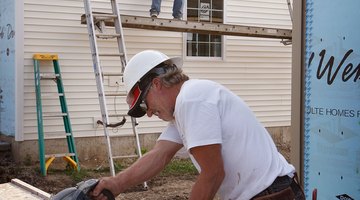How to Replace Stucco With Hardiplank
Replacing stucco with James Hardie international's Hardiplank siding on the exterior of your home dramatically changes the styling of the home. Unfortunately, it isn't a good idea to try to install Hardiplank siding over the top of surfaces that aren't flat and even.

The texture of stucco wall covering makes it easy for bugs and water to invade, which will eventually cause damage. Removing the stucco from the exterior walls of the home is the best option available for the installation.
Things You Will Need
- Hammer
- Chisel
- Trash can
- Vapor barrier
- Staple gun
- Siding nails
- 1/4-inch pressure treated or Hardiplank lath strips
-
Place the chisel against a corner of the wall where the stucco is to be removed, and tap the end of the chisel gently with the hammer. The stucco will gradually begin to flake off of the wood wall that supports it.
-
Place the chisel blade flat against the wood supporting wall so that when struck, it will cleave the stucco from the wood in larger chunks. Continue in this fashion to remove the stucco from the wall on which you are installing the Hardiplank until all of the stucco has been removed. Keep a trash can nearby to help contain some of the mess created by the removal of the stucco.
-
Install vapor barrier over the wood wall by holding it in place and stapling it to the plywood walls. Vapor barrier isn't necessary on stucco walls, but it is necessary on Hardiplank siding construction. Not only does it help prevent water damage to the interior walls, but it can help prevent insect infestations, as well.
-
Install one-quarter-inch lath around the base of the home where the first layer of Hardiplank will be installed. This will help to level the boards and hold them at the correct angle while you install them. Use siding nails to attach the lath to the wall.
-
Install the first level of the Hardiplank siding. The first level should be positioned so that its bottom edge is flush with the bottom of the lath strip you installed at the base of the wall. This will hold the first course of Hardiplank at an angle to the wall that will match the rest of the rows. When installing the Hardiplank, drive the siding nails through the top 2 inches of the siding so that they won't be seen after you install the next row.
-
Overlap the Hardiplank horizontally when you install the second course of siding. This will help to prevent the appearance of severe vertical lines in the siding.
-
Continue installing the Hardiplank siding until you have completely covered the wall. Overlap each course over the course below it to hide the nails used to secure it to the wall. In addition, make certain to install the siding with an equal amount of siding showing on each course in order to maintain a level, professional appearance.

Tip
Create a quick measuring tool to help guide the installation of the Hardiplank siding by cutting a block of wood the size of the measurement between the bottom of each course of Hardiplank. This will allow you to keep the lines of siding even throughout the installation.
Warning
Wear safety goggles when removing the stucco material from the walls of your home. Chiseling concrete such as this can create small chunks of material that can cause injuries if it gets in your eyes.
The Drip Cap
- Replacing stucco with James Hardie international's Hardiplank siding on the exterior of your home dramatically changes the styling of the home.
- The stucco will gradually begin to flake off of the wood wall that supports it.
- Not only does it help prevent water damage to the interior walls, but it can help prevent insect infestations, as well.
- When installing the Hardiplank, drive the siding nails through the top 2 inches of the siding so that they won't be seen after you install the next row.
- Overlap the Hardiplank horizontally when you install the second course of siding.
References
- "Exterior Siding, Trim & Finishes"; Fine Homebuilding Editors; 2004
- "Guide to Concrete: Masonry & Stucco Projects"; Phil Schmidt; 2008
Writer Bio
Don Kress began writing professionally in 2006, specializing in automotive technology for various websites. An Automotive Service Excellence (ASE) certified technician since 2003, he has worked as a painter and currently owns his own automotive service business in Georgia. Kress attended the University of Akron, Ohio, earning an associate degree in business management in 2000.
Photo Credits
- Photos.com/Photos.com/Getty Images
- Photos.com/Photos.com/Getty Images
- Scott Olson/Getty Images News/Getty Images
More Articles



